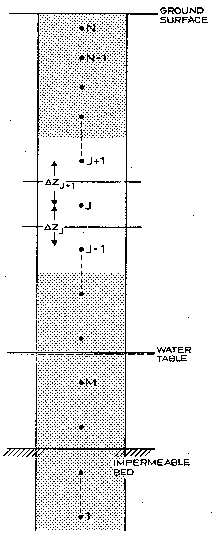
Numerical Solution of Richards Equation
MIKE SHE uses a fully implicit formulation in which the space derivatives of Eq. (28.7) are described by their finite difference analogues at time level n+1. The values of C(q) and K(q) are referred to at time level n+½. These are evaluated in an iterative procedure averaging Cn, Kn with Cm, Km respectively. Cm and Km are calculated as a running average of the coefficients found in each iteration.
This solution technique has been found to eliminate stability and convergence problems arising from the non-linearity of the soil properties.
For an interior node, the implicit scheme yields the following discrete formulation of the vertical flow:
where the subscript J refers to the spatial increment and the superscript n refers to the time increment. The vertical grid system for a soil column is shown in Figure 28.1. Similar to Eq. (28.8) the discrete form of Eq. (28.1) gives
The soil property K is centred in space using the arithmetic mean:
(28.10) 

Figure 28.1 Vertical Discretisation in the Unsaturated Zone.
Eq. (28.9) involves three unknown values at time n+1 and one known value at time n for each node. Written for all nodes with reference to Figure 28.1, a system of N-M+1 equations with N-M+1 unknowns is obtained. The system of equations forms a tri-diagonal matrix:
The J'th row in the matrix is
where
The solution to the matrix system Eq. (28.11) is solved by Gaussian elimination. Assuming that  and
and  can be related in the following recurrence relation
can be related in the following recurrence relation
The EJ+1 and FJ+1 can be calculated by combining Eqs. (28.12) and (28.14) as follows:
Given the boundary conditions at the bottom and top nodes, y is computed for all nodes in a double sweep procedure:
1. E and F values are calculated from Eqs. 28.13 and 28.15 for all nodes from bottom-to-top in a E, F-sweep.
2. y is then calculated from Eq. 28.14 for all nodes in a top-to-bottom sweep.
Briefly, the iterative procedure within each time step is
1. the final result at time n (i.e.  and
and  ) is used for the initial estimate of
) is used for the initial estimate of  and
and  for the first iteration,
for the first iteration,
2. then the following convergence criteria is checked for every node after each iteration, i
(28.16) 
(28.17) 
3. if this convergence criteria is satisfied then a solution at the current time level (i.e. n+1) has been found.
4. if the criteria is not fulfilled then  and
and  are updated for the next iteration by
are updated for the next iteration by
(28.18) 
(28.19) 